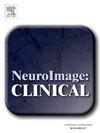Diminished reward circuit response underlies pain avoidance learning deficits in problem drinkers
IF 3.6
2区 医学
Q2 NEUROIMAGING
引用次数: 0
Abstract
Individuals engaging in problem drinking show impaired proactive pain avoidance. As successful pain avoidance is intrinsically rewarding, this impairment suggests reward deficiency, as hypothesized for those with alcohol and substance misuse. Nevertheless, how reward circuit dysfunctions impact avoidance learning and contribute to drinking behavior remains poorly understood. Here, we combined functional imaging and a probabilistic learning go/nogo task to examine the neural processes underlying proactive pain avoidance learning in 103 adult drinkers. We hypothesized that greater drinking severity would be associated with poorer avoidance learning and that the deficits would be accompanied by weakened activity and connectivity of the reward circuit. Our behavioral findings indeed showed a negative relationship between drinking severity and learning from successful pain avoidance. We identified hypoactivation of the posterior cingulate cortex (PCC), a brain region important in avoidance, as the neural correlate of lower learning rate in association with problem drinking. The reward circuit, including the medial orbitofrontal cortex, ventral tegmental area, and substantia nigra, also exhibited diminished activation and connectivity with the PCC with greater drinking severity and learning deficits. Finally, path modeling suggested a pathway in which problem drinking disengaged the reward circuit. The weakened circuit subsequently induced PCC hypoactivation, resulting in poorer pain avoidance learning. As the learning dysfunction worsened alcohol use, the pathway represents a self-perpetuating cycle of drinking and distress. Together, these findings substantiate a role of reward deficiency in problem drinkers’ compromised proactive avoidance, thus identifying a potential target for intervention aimed at mitigating harmful alcohol use.
减少的奖赏回路反应是问题饮酒者的疼痛回避学习缺陷的基础
有酗酒问题的人表现出主动回避疼痛的能力受损。由于成功回避疼痛具有内在奖赏性,因此这种障碍表明存在奖赏缺陷,正如对酒精和药物滥用者的假设一样。然而,人们对奖赏回路功能障碍如何影响回避学习并导致饮酒行为仍然知之甚少。在这里,我们结合功能成像和概率学习 go/nogo 任务,研究了 103 名成年饮酒者主动避痛学习的神经过程。我们假设,饮酒严重程度越高,避痛学习能力越差,同时奖赏回路的活动和连通性也会减弱。我们的行为研究结果确实表明,饮酒严重程度与成功避痛学习之间存在负相关。我们发现,后扣带回皮层(PCC)的低活化是与问题饮酒相关的较低学习率的神经相关性,而后扣带回皮层是一个对回避很重要的脑区。包括内侧眶额皮层、腹侧被盖区和黑质在内的奖赏回路也表现出激活减弱以及与扣带回皮层的连接减弱,这与酗酒严重程度和学习障碍有关。最后,路径建模提出了问题饮酒使奖赏回路脱离的途径。奖赏回路的减弱随后诱发了PCC的低激活,导致避痛学习能力下降。由于学习功能障碍加剧了饮酒,该路径代表了饮酒和痛苦的自我循环。这些发现共同证实了奖赏缺失在问题饮酒者受损的主动回避中的作用,从而确定了旨在减少有害酒精使用的潜在干预目标。
本文章由计算机程序翻译,如有差异,请以英文原文为准。
求助全文
约1分钟内获得全文
求助全文
来源期刊

Neuroimage-Clinical
NEUROIMAGING-
CiteScore
7.50
自引率
4.80%
发文量
368
审稿时长
52 days
期刊介绍:
NeuroImage: Clinical, a journal of diseases, disorders and syndromes involving the Nervous System, provides a vehicle for communicating important advances in the study of abnormal structure-function relationships of the human nervous system based on imaging.
The focus of NeuroImage: Clinical is on defining changes to the brain associated with primary neurologic and psychiatric diseases and disorders of the nervous system as well as behavioral syndromes and developmental conditions. The main criterion for judging papers is the extent of scientific advancement in the understanding of the pathophysiologic mechanisms of diseases and disorders, in identification of functional models that link clinical signs and symptoms with brain function and in the creation of image based tools applicable to a broad range of clinical needs including diagnosis, monitoring and tracking of illness, predicting therapeutic response and development of new treatments. Papers dealing with structure and function in animal models will also be considered if they reveal mechanisms that can be readily translated to human conditions.
 求助内容:
求助内容: 应助结果提醒方式:
应助结果提醒方式:


